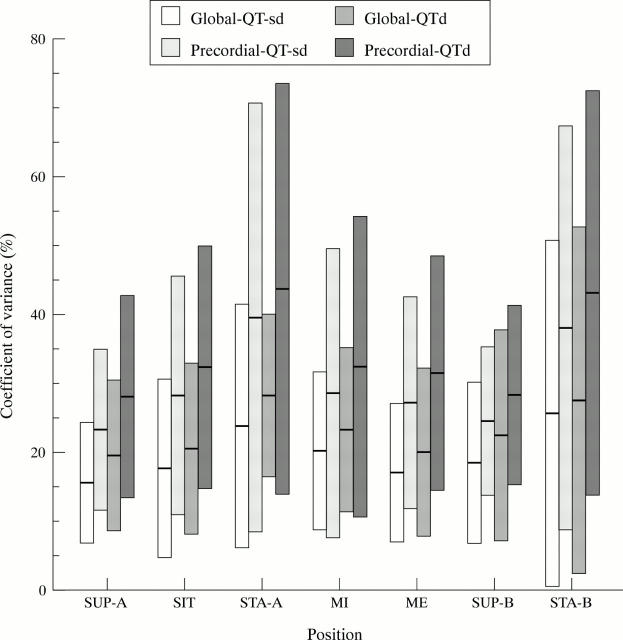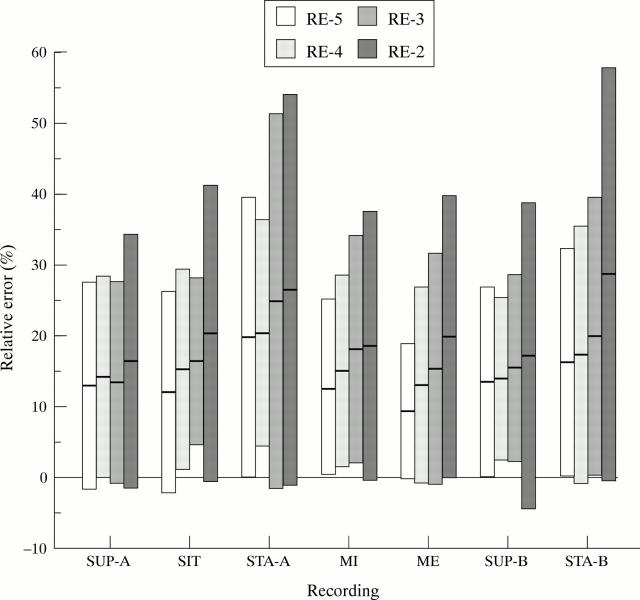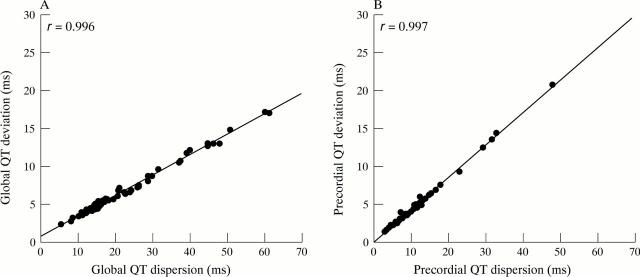Abstract
Objective—To assess the stability and reproducibility of computerised QT dispersion (QTd) measurement in healthy subjects, as this is presently being incorporated into commercial electrocardiographic systems. Methods—70 healthy volunteers (mean (SD) age 38 (10) years, 35 men, 35 women) with a normal 12 lead electrocardiogram (ECG) were studied. From each subject, 70 ECG recordings were taken using the MAC VU ECG recorder (Marquette). In study A, 50 ECGs were recorded in each subject: 10 supine, 10 sitting, 10 standing, 10 holding breath in maximum inspiration, and 10 holding breath in maximum expiration. After a mean interval of 8 (3) days (range 7 to 23), 10 recordings in supine and 10 in the standing position were repeated in each subject (study B). On measurements made using a research version of the commercial software without manual modification, the reproducibility of QTd was assessed by coefficient of variance (CV) and relative error, and comparisons made with other ECG indices. Results—(1) QTd measurements were stable and not influenced by changes in posture and respiratory cycle; (2) there was no difference in QTd measurements between men and women, or between age groups dichotomised at 35 years; (3) no correlation was found between QTd and heart rate or QT interval; (4) short term reproducibility of all QTd measurements (CV 15.6% to 43.8%) was worse than that of conventional ECG indices (CV 1.4% to 5.3%); (5) long term reproducibility of QTd measurements (relative error 27.4% to 31.0%) was also worse than that of conventional ECG indices (relative error 1.8% to 7.9%) (p < 0.0001); (6) the reproducibility of QTd measurements tended to increase when several serial recordings were averaged. Conclusions—Computerised measurements of global QTd and global QT-SD from 12 lead ECG by the MAC VU/QT Guard system are not significantly altered by changes in posture and respiration. The reproducibility of all QTd measurements is inferior to that of conventional ECG indices in healthy subjects. Keywords: QT dispersion; reproducibility; automatic measurement; healthy subjects
Full Text
The Full Text of this article is available as a PDF (185.8 KB).
Figure 1 .
Mean values and standard deviations of coefficient of variance of QT dispersion measurements in the seven various positions. ME, ECG recordings on maximum expiration in study A; MI, ECG recordings on maximum inspiration in study A; SIT, ECG recordings when sitting in study A; STA-A/B, ECG recordings when standing in study A/B; SUP-A/B, ECG recordings in the supine position in study A/B.
Figure 2 .
Relative errors for global QT dispersion measurement in seven various conditions. RE-2 (RE-3, RE-4, or RE-5): relative error calculated using the formula |A-B|/[(A+B)/2], where the first measure A was obtained by averaging the measures of the first two (three, four, or five) of the 10 consecutive ECG recordings, and the second measure B was obtained by averaging the next two (three, four, or five) recordings. ME, ECG recordings on maximum expiration in study A; MI, ECG recordings on maximum inspiration in study A; SIT, ECG recordings when sitting in study A; STA-A/B, ECG recordings when standing in study A/B; SUP-A/B, ECG recordings in the supine position in study A/B.
Figure 3 .
The correlation between the measurements of global QT dispersion and global QT standard deviation (A); and between the measurements of precordial QT dispersion and precordial QT standard deviation (B).
Figure 4 .
The correlation between the measurements of QT interval and heart rate (A); between global QT dispersion and heart rate (B); and between global QT dispersion and QT interval (C). All measures presented here are from study A in the supine position.
Selected References
These references are in PubMed. This may not be the complete list of references from this article.
- Barr C. S., Naas A., Freeman M., Lang C. C., Struthers A. D. QT dispersion and sudden unexpected death in chronic heart failure. Lancet. 1994 Feb 5;343(8893):327–329. doi: 10.1016/s0140-6736(94)91164-9. [DOI] [PubMed] [Google Scholar]
- Browne K. F., Zipes D. P., Heger J. J., Prystowsky E. N. Influence of the autonomic nervous system on the Q-T interval in man. Am J Cardiol. 1982 Nov;50(5):1099–1103. doi: 10.1016/0002-9149(82)90425-8. [DOI] [PubMed] [Google Scholar]
- Buja G., Miorelli M., Turrini P., Melacini P., Nava A. Comparison of QT dispersion in hypertrophic cardiomyopathy between patients with and without ventricular arrhythmias and sudden death. Am J Cardiol. 1993 Oct 15;72(12):973–976. doi: 10.1016/0002-9149(93)91118-2. [DOI] [PubMed] [Google Scholar]
- Cappato R., Alboni P., Pedroni P., Gilli G., Antonioli G. E. Sympathetic and vagal influences on rate-dependent changes of QT interval in healthy subjects. Am J Cardiol. 1991 Nov 1;68(11):1188–1193. doi: 10.1016/0002-9149(91)90192-n. [DOI] [PubMed] [Google Scholar]
- Day C. P., McComb J. M., Campbell R. W. QT dispersion: an indication of arrhythmia risk in patients with long QT intervals. Br Heart J. 1990 Jun;63(6):342–344. doi: 10.1136/hrt.63.6.342. [DOI] [PMC free article] [PubMed] [Google Scholar]
- Fei L., Statters D. J., Camm A. J. QT-interval dispersion on 12-lead electrocardiogram in normal subjects: its reproducibility and relation to the T wave. Am Heart J. 1994 Jun;127(6):1654–1655. doi: 10.1016/0002-8703(94)90409-x. [DOI] [PubMed] [Google Scholar]
- Glancy J. M., Garratt C. J., Woods K. L., de Bono D. P. QT dispersion and mortality after myocardial infarction. Lancet. 1995 Apr 15;345(8955):945–948. doi: 10.1016/s0140-6736(95)90697-5. [DOI] [PubMed] [Google Scholar]
- Glancy J. M., Weston P. J., Bhullar H. K., Garratt C. J., Woods K. L., de Bono D. P. Reproducibility and automatic measurement of QT dispersion. Eur Heart J. 1996 Jul;17(7):1035–1039. doi: 10.1093/oxfordjournals.eurheartj.a014999. [DOI] [PubMed] [Google Scholar]
- Grimm W., Steder U., Menz V., Hoffman J., Maisch B. QT dispersion and arrhythmic events in idiopathic dilated cardiomyopathy. Am J Cardiol. 1996 Aug 15;78(4):458–461. doi: 10.1016/s0002-9149(96)00337-2. [DOI] [PubMed] [Google Scholar]
- Hii J. T., Wyse D. G., Gillis A. M., Duff H. J., Solylo M. A., Mitchell L. B. Precordial QT interval dispersion as a marker of torsade de pointes. Disparate effects of class Ia antiarrhythmic drugs and amiodarone. Circulation. 1992 Nov;86(5):1376–1382. doi: 10.1161/01.cir.86.5.1376. [DOI] [PubMed] [Google Scholar]
- Hnatkova K., Malik M., Kautzner J., Gang Y., Camm A. J. Adjustment of QT dispersion assessed from 12 lead electrocardiograms for different numbers of analysed electrocardiographic leads: comparison of stability of different methods. Br Heart J. 1994 Oct;72(4):390–396. doi: 10.1136/hrt.72.4.390. [DOI] [PMC free article] [PubMed] [Google Scholar]
- Kautzner J., Yi G., Camm A. J., Malik M. Short- and long-term reproducibility of QT, QTc, and QT dispersion measurement in healthy subjects. Pacing Clin Electrophysiol. 1994 May;17(5 Pt 1):928–937. doi: 10.1111/j.1540-8159.1994.tb01435.x. [DOI] [PubMed] [Google Scholar]
- Leitch J., Basta M., Dobson A. QT dispersion does not predict early ventricular fibrillation after acute myocardial infarction. Pacing Clin Electrophysiol. 1995 Jan;18(1 Pt 1):45–48. doi: 10.1111/j.1540-8159.1995.tb02474.x. [DOI] [PubMed] [Google Scholar]
- Linker N. J., Colonna P., Kekwick C. A., Till J., Camm A. J., Ward D. E. Assessment of QT dispersion in symptomatic patients with congenital long QT syndromes. Am J Cardiol. 1992 Mar 1;69(6):634–638. doi: 10.1016/0002-9149(92)90155-r. [DOI] [PubMed] [Google Scholar]
- Mirvis D. M. Spatial variation of QT intervals in normal persons and patients with acute myocardial infarction. J Am Coll Cardiol. 1985 Mar;5(3):625–631. doi: 10.1016/s0735-1097(85)80387-9. [DOI] [PubMed] [Google Scholar]
- Priori S. G., Napolitano C., Diehl L., Schwartz P. J. Dispersion of the QT interval. A marker of therapeutic efficacy in the idiopathic long QT syndrome. Circulation. 1994 Apr;89(4):1681–1689. doi: 10.1161/01.cir.89.4.1681. [DOI] [PubMed] [Google Scholar]
- Tieleman R. G., Crijns H. J., Wiesfeld A. C., Posma J., Hamer H. P., Lie K. I. Increased dispersion of refractoriness in the absence of QT prolongation in patients with mitral valve prolapse and ventricular arrhythmias. Br Heart J. 1995 Jan;73(1):37–40. doi: 10.1136/hrt.73.1.37. [DOI] [PMC free article] [PubMed] [Google Scholar]
- Zareba W., Moss A. J., le Cessie S. Dispersion of ventricular repolarization and arrhythmic cardiac death in coronary artery disease. Am J Cardiol. 1994 Sep 15;74(6):550–553. doi: 10.1016/0002-9149(94)90742-0. [DOI] [PubMed] [Google Scholar]
- van de Loo A., Arendts W., Hohnloser S. H. Variability of QT dispersion measurements in the surface electrocardiogram in patients with acute myocardial infarction and in normal subjects. Am J Cardiol. 1994 Dec 1;74(11):1113–1118. doi: 10.1016/0002-9149(94)90462-6. [DOI] [PubMed] [Google Scholar]






